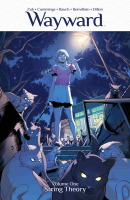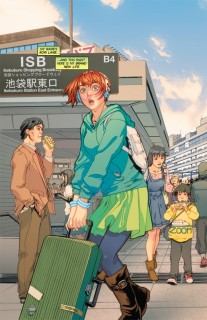 Creator: Jim Zub and Steve Cummings
Creator: Jim Zub and Steve Cummings
Publisher: Image Comics
ISBN: 9781632151735
Released: March 2015
Original run: 2014
Wayward is an ongoing comic series created by Jim Zub and Steve Cummings and published by Image Comics. Zub, a creator from Canada, is primarily responsible for writing the story while Cummings, currently based in Japan, is the series’ line artist. Along with Tamra Bonvillain, Ross A. Campbell, Josh Perez, and John Rauch, Zub also worked on the comics’ color art with additional flats done by Ludwig Olimba. Wayward was first brought to my attention due to Zub’s involvement—I had previously read and enjoyed some of his other work—but my curiosity was piqued even more when I learned that Zack Davisson was writing bonus material for the series in the form of background information on yokai. It’s not a secret that I have a particular fondness for yokai; I was very interested in seeing what sort of role Japan’s mythological and legendary creatures would play in the comic. The first trade collection, String Theory, was published in 2015. It includes the first five issues of Wayward originally released in 2014 as well as additional essays written by Davisson.
Not long after her parents divorced, Rori Lane left Ireland to be with her mother in Japan. Living with her father just wasn’t working for any of them. Of course, this does mean that Rori will have to start her life over again in a county she’s never even visited. Her mother may be a native Tokyoite, but the city is unlike anywhere else she’s ever been before. For a loner like Rori, and for a young half-Japanese woman such as herself, fitting in and feeling comfortable in Japan and at her new school won’t be an easy task. To complicate matters further, she has a curious but occasionally useful ability that allows her to see the patterns connecting people, places, and events. And to some small extent, she can even control the world around her because of it. By following those threads of destiny, she finds herself drawn to several young people who are also gifted in peculiar ways. It’s good to have found a small group of friends, people around whom she can feel a little more at ease, but it’s not long before they are all pulled into a dangerous power struggle within the city that they don’t even understand.
 String Theory provides a fantastic start to Wayward, a contemporary fantasy action series with prominent influences drawn from traditional Japanese folklore with modern twists. Rori encounters various yokai throughout String Theory, beginning with a trio of monstrous and extremely dangerous kappa. Although the designs, abilities, and basic natures of the yokai in String Theory are directly inspired by their original counterparts, they are also distinctive to Wayward. It all works very well. The series is action-packed, with dramatic supernatural battles, but it also has more introspective personal conflicts as well. Rori finds herself overwhelmed, thrust into circumstances to which she brings very little knowledge. As String Theory progresses, more and more is revealed about how the world of the series functions as Rori herself begins to piece together how it works. As Rori learns more so do the readers, but there are still plenty of mysteries that have yet to be fully explored.
String Theory provides a fantastic start to Wayward, a contemporary fantasy action series with prominent influences drawn from traditional Japanese folklore with modern twists. Rori encounters various yokai throughout String Theory, beginning with a trio of monstrous and extremely dangerous kappa. Although the designs, abilities, and basic natures of the yokai in String Theory are directly inspired by their original counterparts, they are also distinctive to Wayward. It all works very well. The series is action-packed, with dramatic supernatural battles, but it also has more introspective personal conflicts as well. Rori finds herself overwhelmed, thrust into circumstances to which she brings very little knowledge. As String Theory progresses, more and more is revealed about how the world of the series functions as Rori herself begins to piece together how it works. As Rori learns more so do the readers, but there are still plenty of mysteries that have yet to be fully explored.
The worldbuilding in String Theory is excellent. Even with the phenomenal powers of the main characters and the presence of yokai and monsters, the supernatural Tokyo of Wayward looks and feels like a real place. A large part of this is due to Cummings’ wonderful illustrations and the work of the series’ colorists. I love the colors in String Theory. They range from muted and subdued palettes to colors that are flashy and vibrant, almost appearing to glow. String Theory can be violent and grotesque and includes elements of horror, but it is also beautifully illustrated. I also particularly liked the visual representation of Rori’s abilities, reminiscent of the concept of the red string of fate found in Japanese culture. The characters introduced in String Theory are great, too; I’m very curious to see how their fated destinies will continue to weave together. I thoroughly enjoyed the first volume of Wayward—it has chaotic action as well as quiet moments, humor as well as drama—and look forward to the next installment a great deal.

I like that you cover non-manga comics too. Based on your recommendation, I decided to pick this up at the comic shop and indeed, I can’t wait for the next volume! I could do single issues, but as a manga person used to getting volumes at a time, I just can’t seem to bring myself to buy single issues.
Oh, I’m so glad to hear that you enjoyed it! I very rarely buy single issues anymore—generally only for stand-alone comics or series that I want to try before deciding whether or not to collect the trades (or on rare occasion for art projects)—so I’ll most likely be waiting for the second volume of Wayward until August/September, too. (Also, I’m glad to know you appreciate the non-manga comics coverage!)
I’ve only really started getting into more non-manga comics recently when a forum I frequent had a thread about it and I found some things to read. though I had read Bone already. But it got me hooked on ElfQuest. And a while back, another friend suggested Habibi. And enough people on the manga bookshelf (i.e. all) loved Off*Beat that I went for that too. Not sure why I tried Saga, I just kind of saw it all over the comic shops and went “eh, ok, library” where before I decided to broaden my horizons, I might’ve ignored it. Of course, I also get comics for cartoons I like, like Adventure Time and whatnot.
And it was maybe two years ago that I decided to get into manhwa. Before that, I only had three manhwa titles on my shelf: Hotel Africa, 1001 Nights, and Threads of Time. Now I have Goong, 100% Perfect Girl, Antique Gift Shop, Not So Bad, Void’s Enigmatic Mansion, Witch Buster and tons more.
I’ll be waiting until Aug/Sep too for more Wayward it seems. Also, I always buy random things based on what you guys on here say of things. So many series I wasn’t planning on buying until someone goes “oh, My Love Story is awesome” or “glad xxxHolic is back in print” and puts up a review.
I actually started reading non-manga comics before manga began dominating my reading list, but I never entirely gave them up. Vertigo was my imprint of choice for a very long time, but recently I’ve been getting into more alternative and independent comics. I still read some mainstream stuff, too, though. I do have the first volume of Saga sitting on a shelf, but I’m way behind and haven’t actually read it yet…
How is 100% Perfect Girl, by the way? I’ve been meaning to give it a try since I’ve enjoyed some of Wann’s other works, but haven’t gotten around to trying to find it yet.
100% Perfect Girl is so soapy I could bathe myself in its suds for a month.
Hahaha! Beautiful. ^_^